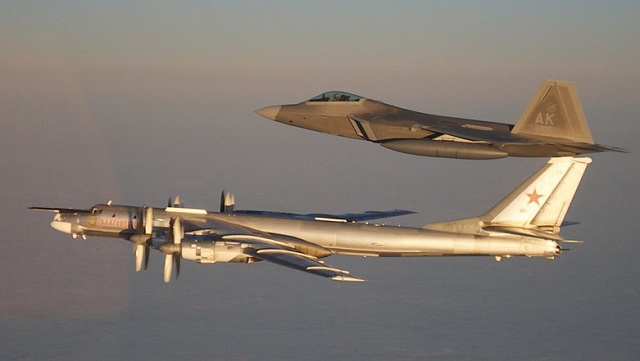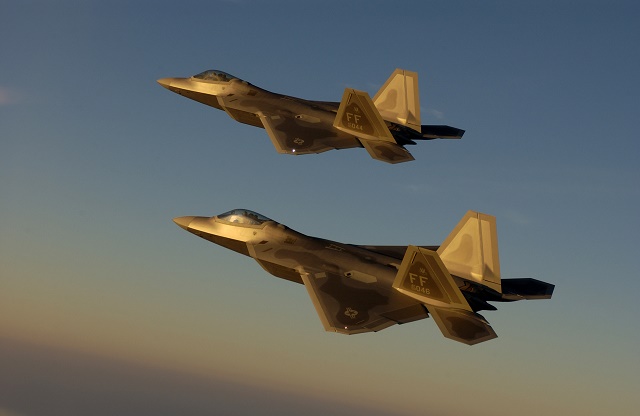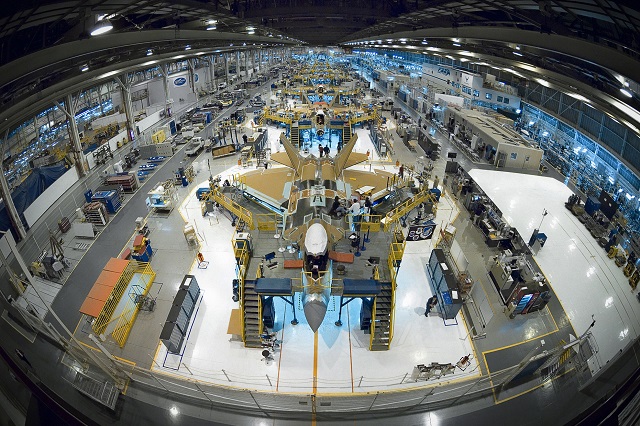The US House Armed Services subcommittee on tactical air and land forces wants to know how much it would cost to resume production of the Lockheed Martin F-22 Raptor air superiority fighter and it is even willing to consider export options and foreign partnerships as an offset.
The US Air Force has spent the past year denying it has any interest in restarting production of the fifth-generation stealth aircraft, which entered combat for the first time in September 2014 against the Islamic State terrorist group in Syria and Iraq. However, the subcommittee’s markup of the fiscal year 2017 defence policy bill this week notes “interest” within the US Air Force, Defense Department and Congress about “potentially restarting production of the F-22 aircraft”.
A legislative directive proposed by the committee on 19 April notes that F-22 production was capped at 187 aircraft, which is “far short of the initial programme objective of 749 aircraft as well as Air Combat Command’s stated requirement of 381 aircraft”.
The proposed language directs the air force secretary to produce an unclassified report “by not later than 1 January 2017” on the cost of building another 194 aircraft. The report must consider variables to the unit cost, such as larger or small quantities and “opportunities for foreign export and partner nation involvement” if the 1998 prohibition on the export of the F-22 advanced tactical fighter to any foreign government could be repealed.
Japan and Australia had wanted to buy the F-22A when it was still in production, but instead, the programme was cancelled in 2009 in favour of pressing ahead with the F-35 Lightning II multirole righter. The 195th and final aircraft was delivered from Marietta, Georgia in May 2012.

US Air Force
The legislative proposal comes as air force officials reconsider developing an expensive and time consuming “silver bullet” sixth-generation fighter jet to succeed the F-22 and F-35. Instead, it wants to develop a nearer-term “family of systems” to sustain America’s air dominance into the 2030s and beyond.
In February, an industry source said the air force had requested a "rough order of magnitude" cost estimates for resuming F-22 production, but the service denied it.
“The air force has no plan to restart F-22 production and therefore has not requested any formal cost estimates in the past year or at any other time since production shutdown,” the service said in a 19 February email. “The air force has no F-22 production restart cost data other than the very rough order of magnitude estimates outlined in the February 2011 RAND study: Retaining F-22A Tooling Options and Costs.”
According to the air force’s summary of the report, it would require approximately $2 billion to resume F-22 production, including $300-500 million in non-recurring start-up costs. Assuming a production run of 75 aircraft over five years, the estimated unit cost would be $233 million.
“The scale and cost of an F-22 production restart has been deemed too prohibitive to pursue,” the air force says.

US Air Force
Roderick McLean, vice-president of Lockheed’s F-16/F-22 integrated fighter group, told Flightglobal at the company’s T-50A next-generation trainer unveiling in February that the air force has asked if would be possible to resume F-22 production. Lockheed’s counterproposal to solving the F-22 capacity issue is to upgrade early-model Block 20 Raptors, which are now used for training and exercises at Tyndall AFB in Florida and Nellis AFB, Nevada. Lockheed delivered 36 F-22 Block 20s and another 149 in the combat-coded Block 30/35 configuration, not including test articles.
“This [upgrade] will allow you to potentially deploy those Block 20 aircraft because they’d have a similar capability to the remaining fleet, effectively making them combat-coded aircraft versus today where they’re just training-coded aircraft,” says McLean. “We haven’t completed the cost estimates, but it is more affordable to modernise the Block 20s compared to restarting the F-22 line. We still have the tooling, but there’s always the effort of re-engaging the supply base and going through that initial development and testing of those first units.”
McLean confirmed that any new-build Raptor would leverage the latest developments in radar and communications technology brought about by the advent of the F-35.

Lockheed Martin
On the propulsion side, Pratt & Whitney has already engaged with its F119 supply base for the thrust-vectoring F119-100 supercruise engine, which propels the Raptor to Mach 2.
“The F-22 is being used a great deal, not only more than the air force had originally project but in harder manner,” P&W military engine chief Bennett Crosswell told Flightglobal in an interview on February 15. “We’ll do 32 overhauls of the F119 engine this year at our heavy maintenance centre at Tinker AFB [in Oklahoma] and next year we’ll double that – so 64 overhauls. The most F119 engines we ever delivered per year when we were in production was 57.”
He says most F119 suppliers haven’t built parts for the F-22 since it went out of production and it will require many cold-starts to boost the expected overhaul rate. Many of those same suppliers now build parts for the F135 engine, which is derived from the F119 turbofan, and are willing and able to resume F-22 parts production, Crosswell says.
Source: FlightGlobal.com
















